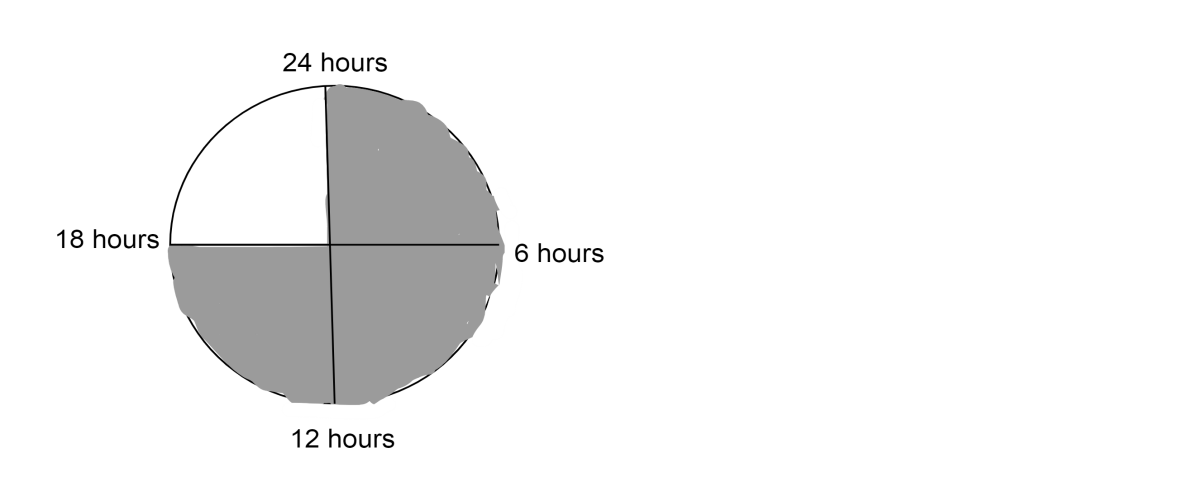
Answer
459k+ views
Hint: In the figure, the circle is divided into four quarters, out of which three are shaded. Since each quarter represents six hours, sleeping hours is three times six and awake time is one time six. Using this we can calculate the ratio.
Useful formula:
The ratio of a quantity $x$ to a quantity $y$ is equal to $\dfrac{x}{y}$, which is also written as $x:y$.
Complete step by step solution:
In the figure, the shaded portion represents the sleeping time of python and the unshaded portion represents the awake time of python.
Let the sleeping time and awake time of python be ${T_S}$ and ${T_A}$ respectively.
Since the circle is divided into four quarters out of which three is shaded and each quarter contains six hours,
Sleeping time of python is three times six, which is equal to $18$ hours.
$ \Rightarrow {T_S} = 18hours$
Awake time of python is the unshaded portion, which contains one quarter of the circle.
So awake time $6 \times 1 = 6$ hours.
$ \Rightarrow {T_A} = 6hours$
We are asked to find the ratio of sleeping time to awake time.
The ratio of a quantity $x$ to a quantity $y$ is equal to $\dfrac{x}{y}$ which is also written as $x:y$.
Therefore, the required ratio is $\dfrac{{{T_S}}}{{{T_A}}} = \dfrac{{18}}{6} = \dfrac{3}{1}$
Ratio of sleeping hours to awake hours is $3:1$.
Note: Order is important when taking ratios. The ratio of a quantity $x$ to a quantity $y$ is equal to $\dfrac{x}{y}$. At the same time, the ratio of quantity $y$ to quantity $x$ is equal to $\dfrac{y}{x}$ .
Useful formula:
The ratio of a quantity $x$ to a quantity $y$ is equal to $\dfrac{x}{y}$, which is also written as $x:y$.
Complete step by step solution:
In the figure, the shaded portion represents the sleeping time of python and the unshaded portion represents the awake time of python.
Let the sleeping time and awake time of python be ${T_S}$ and ${T_A}$ respectively.
Since the circle is divided into four quarters out of which three is shaded and each quarter contains six hours,
Sleeping time of python is three times six, which is equal to $18$ hours.
$ \Rightarrow {T_S} = 18hours$
Awake time of python is the unshaded portion, which contains one quarter of the circle.
So awake time $6 \times 1 = 6$ hours.
$ \Rightarrow {T_A} = 6hours$
We are asked to find the ratio of sleeping time to awake time.
The ratio of a quantity $x$ to a quantity $y$ is equal to $\dfrac{x}{y}$ which is also written as $x:y$.
Therefore, the required ratio is $\dfrac{{{T_S}}}{{{T_A}}} = \dfrac{{18}}{6} = \dfrac{3}{1}$
Ratio of sleeping hours to awake hours is $3:1$.
Note: Order is important when taking ratios. The ratio of a quantity $x$ to a quantity $y$ is equal to $\dfrac{x}{y}$. At the same time, the ratio of quantity $y$ to quantity $x$ is equal to $\dfrac{y}{x}$ .
Recently Updated Pages
10 Examples of Evaporation in Daily Life with Explanations

10 Examples of Diffusion in Everyday Life

1 g of dry green algae absorb 47 times 10 3 moles of class 11 chemistry CBSE

If the coordinates of the points A B and C be 443 23 class 10 maths JEE_Main

If the mean of the set of numbers x1x2xn is bar x then class 10 maths JEE_Main

What is the meaning of celestial class 10 social science CBSE

Trending doubts
Fill the blanks with the suitable prepositions 1 The class 9 english CBSE

Which are the Top 10 Largest Countries of the World?

How do you graph the function fx 4x class 9 maths CBSE

Who was the leader of the Bolshevik Party A Leon Trotsky class 9 social science CBSE

The Equation xxx + 2 is Satisfied when x is Equal to Class 10 Maths

Differentiate between homogeneous and heterogeneous class 12 chemistry CBSE

Difference between Prokaryotic cell and Eukaryotic class 11 biology CBSE

Which is the largest saltwater lake in India A Chilika class 8 social science CBSE

Ghatikas during the period of Satavahanas were aHospitals class 6 social science CBSE





